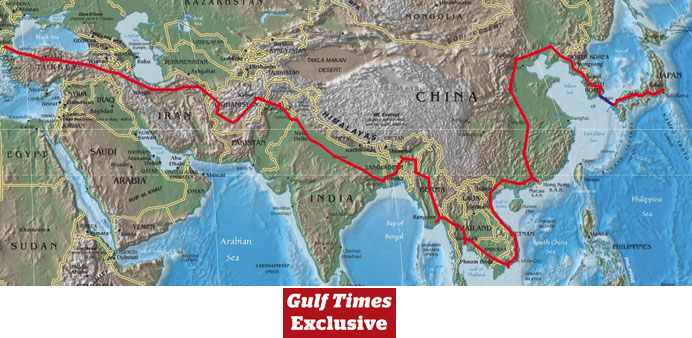The Trans-Asia Highway AH1 spans over more than 20,000km, connecting Tokyo with Istanbul. The route across Myanmar is now passable.
By Arno Maierbrugger/Gulf Times Correspondent/Bangkok
Soon it will be possible to take a relatively pleasant road trip from New Delhi to Bangkok. This November, a new section of Asia Highways 1 and 2 linking India, Myanmar and Thailand will open and reduce travel time further on the way over 3,200km from the border town of Moreh in eastern India to Thailand’s Mae Sot via Myanmar’s Tamu, Mandalay and Myawaddy.
The highway is located in the East-West economic corridor of the Greater Mekong Subregion, a development project implemented in 1992 by the Asian Development Bank that encompasses the states and regions of Cambodia, Laos, Myanmar, Thailand, Vietnam and China’s Yunnan province. The road is further part of the Asian Highway Project, a cooperation between Asian and European countries, as well as the United Nations Economic and Social Commission for Asia and the Pacific.
It has also been prioritised by India’s Prime Minister Narendra Modi who has made the trilateral highway — that would eventually link India by road to entire Southeast Asia — a priority.
It is hoped that the road will help to further grow trade between India, Myanmar and Thailand, particularly after Myanmar’s recent economic opening, and build stronger relationships between the people in the region. Even more, as there are now plans to introduce bus services between India, Myanmar and Thailand which, however, might turn out to be a bit complicated as both India and Thailand have left-side traffic, but Myanmar drives on the right.
The new road stretch will be used by both Asia Highways 1 and 2. Highway number 1, or AH 1, is technically the longest trans-Asian highway spanning over 20,557km. The road begins in Tokyo and, via ferries, connects to South Korea and to Eastern China and leads down to Bangkok and from there across Myanmar, Bangladesh and India to New Delhi and further across Pakistan and Afghanistan to Tehran and into Turkey until it ends at the Bulgarian border. Highway number 2, or AH 2, starts in Denpasar, Indonesia, and leads north to Singapore and Kuala Lumpur. From Bangkok it then shares the road with AH 1 into India where it splits up again, connecting to Lahore in Pakistan and ending in Koshravi, Iran.
However, the network of Asian superhighways is still fragmentary although a complete trip from East Asia to Europe is possible. The first documented car crossing was conducted by two Britons in 2007. They drove an Aston Martin from Tokyo to Istanbul along the AH 1 and Central Asian highway AH 5, a journey that — including ferry trips and customs clearance delays — took 49 days and led 12,089km across 18 countries.
Most of the funding for the trans-Asian highways comes from more advanced Asian nations like Japan, India and China, as well as independent agencies such as the Asian Development Bank. The beneficiaries of the Asian Highway project are mainly less-developed non-coastal areas.
Within Southeast Asia, there are also plans to integrate the highway network with the planned high-speed railways connecting the region with China. One such railway will run from Singapore across Thailand and Laos to China’s southern provincial capital of Kunming in Yunnan province. The project should be completed by 2020 as part of the Trans-Asian Railway initiative whose origins are dating back to the 1960s. When complete, the Trans-Asian Railway network will involve a continuous 14,000km railway track linking Singapore to Turkey, with the possibility of links to the Middle East (Gulf Railway), Africa and Europe, making it theoretically possible to take a train ride from Doha to Beijing.

